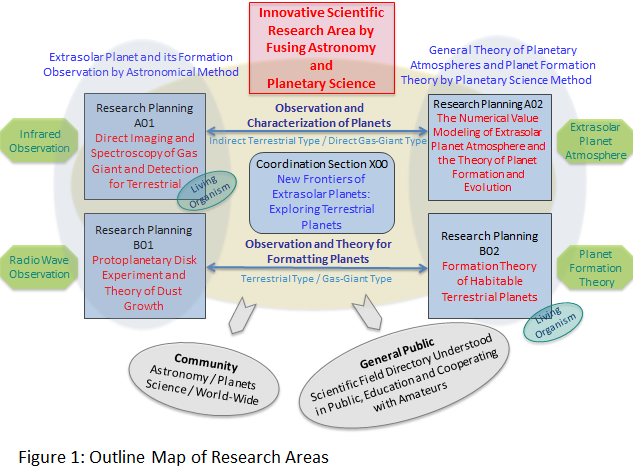Home > For Researchers > Details
Details
Mission
In 1995, a planet revolving around a fixed star other than the Sun was discovered. It is called an extrasolar planet (or exoplanet), and it gave us a new outlook on the universe. With 8 planets in our solar system, there have been more than 500 extrasolar planets discovered, most of which have unique characteristics that we cannot presume exist for the planets in our solar system. These planets include a planet primarily composed of rocks just like the Earth and a planet which is able to maintain liquid water (which presents the possibility of an ocean) on its surface.
Japan has a history of the solar system formation theory especially the "Kyoto Model", and our extrasolar planet formation theory is leading the world. We also started radio wave observation of protoplanetary disks before any other countries. Recently, we have found disks in various shapes with Subaru Telescope, and we successfully conducted direct radiography of extrasolar planets.
In order to develop research in Japan, we continue to research extrasolar planets which were previously outside of our usual research territory. Specifically, we search for planets made of rocks similar to Earth with the possibility of oceans on their surface. We also conduct direct radiography and spectroscopy of planets near a primary star to investigate characteristics of their atmospheres and the births of planets which form from a protoplanetary disk with higher resolution than before. We encourage the comprehensive formation theory of extrasolar planets and theories of planetary atmosphere. By gathering observations, research and theoretical studies, we are aiming to understand the origin of a planet and its formation and evolution as a whole.
In this area of research, we want to strengthen the link between astronomy and planetary science as well as search for the link between life science and other fields of scientific study. It is important to establish planetary science of the extrasolar planets as a new area of study. It has been over a decade since the discovery of extrasolar planets, and there are more students and young people who are interested in this area of study. We cultivate young researchers in a global framework to raise human resources to support future planetary science of extrasolar planets.
Contents
We mainly research the following in this area;
- A01: Direct imaging and spectroscopy of gas giants and detection of terrestrial planets
- For this research, we seek terrestrial planets by using various methods as well as directly detect and disperse the atmosphere of gas-giants to research in detail.
- A02:The Numerical Value Modeling of Extrasolar Planetary Atmospheres and the Theory of Planet Formation and Evolution
- For this research, we construct entire theories of planetary atmospheres and analyze spectroscope data to understand the chemical characterizations of planetary atmospheres.
- B01: From a disk to a planet
- For this research, we encourage observation utilizing ALMA (Atacama Large Millimeter / Submillimeter Array) and the Subaru Telescope to research the process of the formation of planets from disks.
- B02: Formation theory of habitable terrestrial planets
- For this research, we develop the formation theory of planets including the formation of habitable planets to compare with observations to structure the formation theory of a planetary system as a whole.
Expected Outcome and Purpose
The study of extrasolar planets is established to be able to find the scientific answer to Paul Gaugin’s famous questions, "Where did we come from? What are we? Where are we going?” This will be one of the top agendas of studies conducted this century. In this area of research, we expect Japan to take initiative in creating the base of international contribution in this category of basic science.
We search for habitable rocky planets and analyze the details of extrasolar planet atmospheres and the formation of the planets. This topic is quite interesting and is garning widespread attention from society.
In the past 10 years there have been more and more high school students wanting to study extrasolar planets in university or graduate school. It is important for us to establish courses at as many universities as possible to reflect increased interest.

